Mark Sisson's Blog, page 147
March 24, 2018
Kefir Marinated Chicken
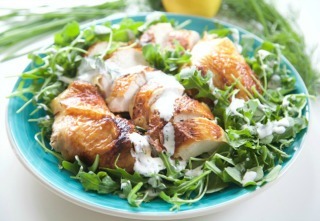 If you think kefir is only a refreshingly tart yogurt drink brimming with healthy probiotics, then you’re missing out on another reason it’s great to have kefir in the kitchen.
If you think kefir is only a refreshingly tart yogurt drink brimming with healthy probiotics, then you’re missing out on another reason it’s great to have kefir in the kitchen.
Kefir is a fantastic marinade for chicken. The acidic nature of kefir makes it the perfect tenderizer, especially for chicken breasts. Kefir also has a way of really soaking the flavors of a marinade into meat. This recipe uses lemon and dill, but any blend of herbs or spices can be whisked into a kefir marinade.
Kefir marinated chicken is tender, succulent and deeply flavorful. If there’s still some kefir left in the bottle, then use it to whisk together a tangy, creamy kefir dressing (recipe below). Leftover chicken tossed into a salad with kefir dressing is a delicious lunch the next day.
Time in the Kitchen: 3-8 hours to marinate, plus 35 minutes to cook
Servings: 4
Chicken
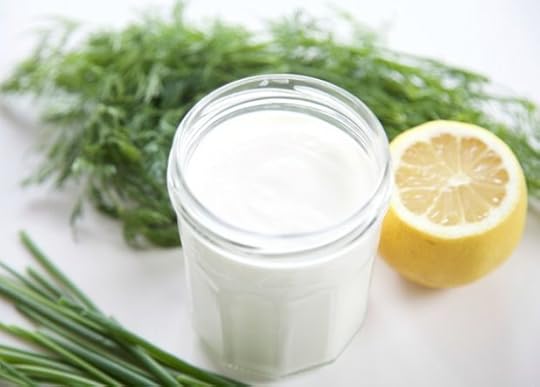
1 cup plain kefir (240 ml)
2 garlic cloves, finely chopped
1/3 cup chopped dill (80 ml)
Zest of half a lemon
2 pounds chicken (breasts, thighs, drumsticks or a combination), with or without skin (900g)
Instructions
Whisk together kefir, garlic, dill, and lemon zest.
Place the chicken in the kefir marinade, making sure each piece is coated.
Marinate at least 3 hours, but preferably overnight.
Remove the chicken from the marinade and shake most of the marinade off. Lightly coat the chicken with oil, then season the chicken with salt and pepper.
Grill the chicken over medium-high heat or roast it in an oven.
Grilling chicken: Pound the thickest part of the chicken breast down to a thickness that is even with the rest of the breast. If the entire breast is ¼ to ½-inch thick grill the breast for about 4 to 6 minutes a side. Drumsticks and thighs can take longer to grill, about 30 minutes, and can be turned more frequently.
Roasting chicken: Preheat oven to 400 ºF/204 ºC. Arrange the chicken pieces on a baking sheet. Bake 20 to 30 minutes. Start checking the breasts after 20 minutes, as they will cook faster.
Cook all chicken to a temperature of 165 °F/74 ºC.
Kefir Dressing

3/4 cup full-fat plain kefir (180 ml)
½ cup Primal Kitchen® Mayo (120 ml) https://www.primalkitchen.com/products/avocado-oil-mayo
1 teaspoon lemon juice (5 ml)
1 tablespoon finely chopped shallot (15 ml)
1 tablespoon finely chopped fresh dill (15 ml)
1 teaspoon finely chopped fresh chives (5 ml)
¼ teaspoon salt
Either whisk ingredients together, or blend in a blender.
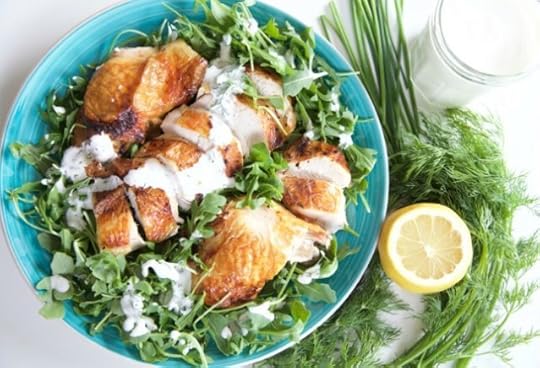
The post Kefir Marinated Chicken appeared first on Mark's Daily Apple.



March 23, 2018
I Find This Journey a Joyous Experience
It’s Friday, everyone! And that means another Primal Blueprint Real Life Story from a Mark’s Daily Apple reader. If you have your own success story and would like to share it with me and the Mark’s Daily Apple community please contact me here. I’ll continue to publish these each Friday as long as they keep coming in. Thank you for reading!
 I started my Primal journey in mid-2007 at age 47. I was tired of being fat with a fat belly. I was tired of not feeling good when I got up. I was tired of the arthritis in my lower back which made it hard to walk some days. I was tired of being tired. I had blood sugar problems and was concerned I would become diabetic. I refused to believe it was an inevitable consequence of getting older. I had been reading books on sugar addiction and thought “That’s me”!
I started my Primal journey in mid-2007 at age 47. I was tired of being fat with a fat belly. I was tired of not feeling good when I got up. I was tired of the arthritis in my lower back which made it hard to walk some days. I was tired of being tired. I had blood sugar problems and was concerned I would become diabetic. I refused to believe it was an inevitable consequence of getting older. I had been reading books on sugar addiction and thought “That’s me”!
I started Atkins Inception phase and stuck with it for 3 months. The first 10 days were agony! I felt sick and groggy, but I stuck with it. By 2 weeks, I realized I felt pretty good. I did not have the morning aches and pains. My head was clear and I had lots of energy. Because I felt so good, and because I had other people around me trying to find a healthier diet, I was able to stick with that very strict diet for 3 months.
I had kicked the sugar addiction, but was really craving things with wheat. I tried adding back starches by having some pasta one night. The next morning was just agony. My back hurt so bad I could barely get out of bed and walking was extremely difficult. I decided I was gluten intolerant. While I did continue to include starches in my diet, by staying gluten-free I was mostly pain free.
I moved to a new job in 2008 and left my health conscious friends behind. (I work on a contract basis so it is common for me to change jobs every 2-3 years.) While I tried to stay low carb, no one around me saw the benefits, including my husband. Without the support of other people doing low carb, I found it too hard to resist bread, potatoes, and corn, though I did stay mostly gluten free (arthritis pain was a great motivator for that). The weight I had lost on Atkins came back.
 That’s me in the ponytail, blue shirt, and white pants touring on a London street summer 2008. I particularly notice the fat arms and dimpled elbows.
That’s me in the ponytail, blue shirt, and white pants touring on a London street summer 2008. I particularly notice the fat arms and dimpled elbows.
In 2009-2011 I was in South Wales with my husband, who was pursuing a Masters degree. I found staying gluten-free was easier than in the U.S. I found that Europeans in general were more aware of where their food came from. Produce and meat were labeled with the farm it came from. Organic and GMO free was easy to find. Starches were also easy to find, especially white potatoes. I was doing some work in Ethiopia at the time, where people in general are not concerned that they are getting too many calories. Being fat was a sign of wealth and prosperity. While it was easy to eat modest amounts of protein, carbs were a large part of the diet. Injera, a bread made from teff flour, was used to pick up and eat the various colorful and spicy dishes served at each meal. While teff is gluten-free, I was eating a lot of high-carb food.
In 2012, now back in the U.S., I started a new job with several of my buddies from 2007 and some new health conscious friends. A small group of us made a habit of eating lunch together daily, and dinner once a week, and we encouraged each other in Primal eating habits. I’m not sure when I found Mark’s Daily Apple, but it was around this time period. From 2012 through 2013 I lost 40 pounds and felt terrific. My husband liked my lighter look, but I still could not convince him to try Primal, even though he wanted to lose weight.

Here I am at Christmas 2013 at the Alamo, down to 165. I had more weight I wanted to lose, but my weight loss stalled. I kept to Primal for many months, but I was discouraged by the lack of weight loss. My contract ended and I parted ways with my Primal buddies. I gained back all I had lost, though I was much better at staying gluten-free than I had ever been.

Here I am summer 2016 with my family at Niagara Falls. I was not quite back up to 205, but you can see I’m much heavier than the previous photo. And I’m not the only person in my family struggling with excess weight!
At the start of 2017, I was back up to 205 pounds. I went back to low carb eating and lost 20 pounds in the first 3 months. Then my weight loss stalled for 6 months, but I stuck to the low carb diet. Mark announced he was publishing the Keto Reset Diet and I determined to get it, read it, and figure out what I was doing wrong. Not only that, my husband (100 pounds overweight, now diabetic too, and diagnosed with bipolar II), finally cared enough about his health to change his diet.
I found that while I was pretty good at eating low carb, I was actually getting too much protein and not enough fat. I decided to go full keto with a reduced eating window and my fat started melting off. My husband was unwilling to give up sugar and starches, but I convinced him to get his daily carbs down to 150 grams (and now he is down to 100 grams a day). He started losing weight as well. For both of us, the change of diet has brought increased energy which makes it easier to exercise more. My husband’s moods have evened out. We are looking forward to his next checkup to see if his blood sugar numbers have improved.
We have both found that eating low carb is not the hard part of Primal. The hard part for us is keeping the amount of protein we eat to a modest level (especially since neither of us is a big salad fan). Since we are both living a Primal lifestyle, it is easier for each of us to stay with it. Every day is not a perfect Primal day and that is alright too.
I do not have a current photo, but I am just a bit below my weight in the San Antonio picture and look much the same. I just had to buy another new belt. I am definitely losing belly fat and am generally thinner all over.
While the weight loss is great for so many reasons, the best part for me is how I feel. I wake up naturally at dawn each day feeling really good. I have tons of energy throughout the day. I do not worry about when I will have the next meal. I’m playing around with new ideas for recipes, especially vegetables. I’m having fun with this, so much so that I completed Primal Health Coach certification for my own education and to help others who want the benefits of Primal. I am considering taking a degree in Nutrition and making a complete career change. I am not perfect, I am not yet at my ideal body composition, but I see Primal as a journey, not a destination. I am finding this journey a joyous experience.

The post I Find This Journey a Joyous Experience appeared first on Mark's Daily Apple.



March 22, 2018
Guest Video: Stocking a Primal Pantry
 Today’s awesome guest video is served up by Christa Orecchio, Founder of The Whole Journey. I think you’ll enjoy her personal shopping tour and helpful tips today.
Today’s awesome guest video is served up by Christa Orecchio, Founder of The Whole Journey. I think you’ll enjoy her personal shopping tour and helpful tips today.
Stocking a Primal kitchen can be fun but sometimes also tricky as you want to be sure products use the correct ingredients and sourcing. Today I’ll go beyond the basics of a Primal kitchen and help you find the most versatile and flavorful options in the store! I think you’ll be surprised by a few of them.
Today I’ll walk you through the aisles and share expert tips for:
Navigating the Bulk Section for Health and Cost-Effectiveness
Upgrading Your Snack Cabinet
Using Super Foods to Boost Health and Mood
How to Use Healthy Condiments and Sea Vegetables
The full 14-part Food As Medicine Healthy Shopping course navigates each section of the store (90 minutes of video) and will help you find healthy choices in any grocery store! These tips and tricks will help you improve your weight, mood, and digestion. Check out the full 14-part grocery store tour here.
 Christa Orecchio, founder of The Whole Journey is a clinical and holistic nutritionist with a passion for helping as many people as possible to heal and achieve vibrant health. After healing herself from chronic candida, brain fog, thyroid and adrenal problems, Christa was able to access a new level of health and happiness she previously did not think was possible. This inspired her to leave the business world to study holistic nutrition in 2003 so that should could “pay it forward” and help others experience the same powerful shifts. Christa combines her holistic and scientific knowledge to help people heal from the root cause using food as their medicine with a mind, body, spirit approach to wholeness. She has 10 years private practice experience, is a local and national health TV show host, bestselling author of How to Conceive Naturally and creator of Kick Candida for Good and the revolutionary Gut Thrive in 5 microbiome rejuvenation program. Learn more about Christa at thewholejourney.com.
Christa Orecchio, founder of The Whole Journey is a clinical and holistic nutritionist with a passion for helping as many people as possible to heal and achieve vibrant health. After healing herself from chronic candida, brain fog, thyroid and adrenal problems, Christa was able to access a new level of health and happiness she previously did not think was possible. This inspired her to leave the business world to study holistic nutrition in 2003 so that should could “pay it forward” and help others experience the same powerful shifts. Christa combines her holistic and scientific knowledge to help people heal from the root cause using food as their medicine with a mind, body, spirit approach to wholeness. She has 10 years private practice experience, is a local and national health TV show host, bestselling author of How to Conceive Naturally and creator of Kick Candida for Good and the revolutionary Gut Thrive in 5 microbiome rejuvenation program. Learn more about Christa at thewholejourney.com.
Thanks again to Christa for the Primal tour today. Have questions or your own ideas for navigating the grocery aisles? Share them down below, and thanks for stopping by today, everyone.
Finally, want to take advantage of Christa’s final shopping tip? We’ve got you covered with a brand new Primal Kitchen Avocado Oil Spray.
The post Guest Video: Stocking a Primal Pantry appeared first on Mark's Daily Apple.



March 21, 2018
Can Keto Actually Work For Hard-Training Endurance or Power/Strength Athletes?
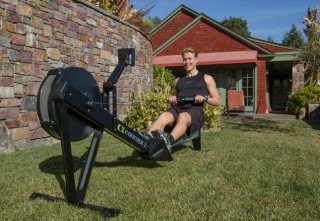 Keto is red hot these days, and it’s not going away anytime soon. Call it the latest dietary fad, but keep in mind a great insight Robb Wolf told Joe Rogan on his podcast: keto was “likely the default human metabolic state” over the past 2.5 million years of human evolution. Only with the extremely recent (on the evolutionary timeline) advent of civilization have we been stuffing our faces with carbs and snuffing out our magnificent ability to generate ketones as a clean-burning alternative fuel source to dietary carbohydrates. And we certainly were compelled to evolve a highly efficient mechanism to keep our high energy demand brains fueled with glucose or the glucose-like substitute of ketones at all times—for this was a matter of life or death in primal times. When our ancestors were starving, they needed to keep working hard, and concentrating hard, to find food!
Keto is red hot these days, and it’s not going away anytime soon. Call it the latest dietary fad, but keep in mind a great insight Robb Wolf told Joe Rogan on his podcast: keto was “likely the default human metabolic state” over the past 2.5 million years of human evolution. Only with the extremely recent (on the evolutionary timeline) advent of civilization have we been stuffing our faces with carbs and snuffing out our magnificent ability to generate ketones as a clean-burning alternative fuel source to dietary carbohydrates. And we certainly were compelled to evolve a highly efficient mechanism to keep our high energy demand brains fueled with glucose or the glucose-like substitute of ketones at all times—for this was a matter of life or death in primal times. When our ancestors were starving, they needed to keep working hard, and concentrating hard, to find food!
The thought leaders and scientists in the keto scene have been establishing the case for keto very well: ketogenic eating really works for virtually everyone if you follow the correct approach. You can expect not only the efficient reduction of excess body fat, but a profound anti-inflammatory effect that can correct assorted autoimmune and inflammatory conditions; improved cognitive function and protection against the disturbingly prevalent conditions of cognitive decline (that are being increasingly connected to high carb, nutrient deficient diets); and assorted anti-aging benefits such as enhanced autophagy (the natural cellular detoxification process) and apoptosis (the programmed death of dysfunctional/pre-cancerous cells).
Keto has also been touted as potentially improving athletic performance for both endurance and strength/power efforts. However, this has become a matter of some dispute in the fitness world, as high calorie burning folks have a hard time embracing the idea that they can benefit from consuming fewer calories and rejecting the obsession with immediate refueling to restore glycogen after vigorous workouts. Today’s post will introduce you to the amazing Sami Inkinen, one of the world’s most accomplished endurance athletes who also has a high profile career as a Silicon Valley entrepreneur. Sami has taken keto experimentation to the extreme, and quantified everything beautifully to illustrate the amazing transformation that happens when you become a fat- and keto-adapted as an athlete.
The Keto Reset Diet goes into great detail about how keto can benefit endurance performance by making athletes virtually bonk-proof—able to perform for hours on end with a dramatically reduced need for carbohydrates as a fuel source. Sami’s story is told in further detail in Primal Endurance and on his blog. Here, he has taken the time from his busy schedule to share some extensive thoughts on how you really can succeed in endurance sports while eating ketogenically, if you follow the correct approach.
Being fat- and keto-adapted is an obvious benefit for endurance, since endurance performance is predicated on being burning more fat and sparing glycogen. The benefits of keto for strength/power athletes is less logical, because high intensity, high glycolytic (high glucose burning) workouts would seem to beget carbohydrate consumption in order to recover and replenish glycogen-depleted muscles. However, keto pioneers in the power scene have discovered amazing results, which are being increasingly validated by science at places like the Applied Science and Performance Institute in Tampa, FL, with Ryan Lowery and Dr. Jacob Wilson. Luis Villasenor, the legendary “DarthLuiggi” in the keto scene, has followed a ketogenic diet as a competitive powerlifter and bodybuilder for some 16 years! Through his KetoGains.com program, he and his team have coached thousands of high intensity athletes to improved performance and improved body composition. Luis is a living, breathing example that you do not have to destroy your health with massive overconsumption of carbs and protein to maintain a bodybuilder physique.
We’ll hear more from Luis and others about how to utilize keto for high intensity performance in the future. Briefly, fasting and ketogenic eating have been shown to have a remarkable protein-sparing effect. It makes evolutionary sense that your body would initiate assorted mechanisms to preserve lean muscle mass when you are starving. Unfortunately, in the carbohydrate dependency paradigm, your body routinely converts lean muscle tissue into glucose via gluconeogenesis to meet your energy needs, especially for the brain (only two percent of body weight, but consuming 20-25 percent of total calories!)— a ravenous consumer of glucose. For carb dependent athletes who don’t remain constantly glycogen stocked, bad things happen with fatigue, delayed recovery, and loss of lean mass. This is why bodybuilders have been urged to eat their six small meals throughout the day and obsessively overconsume protein and carbs to spur growth. Luis and others have shattered this paradigm by getting big, strong, and lean in full keto mode.
Back to endurance, where for decades the conventional thinking was to carb load with your evening pasta feeds and morning cereal troughs, train super hard so you can go harder and longer without falling apart, and possibly train the body to store more glycogen (yes, it’s possible to a minor extent, but soon you will learn how irrelevant this is), and to stuff sugary drinks, gels, and cubes down your throat, hopefully without gagging. Finally, it was believed essential to stuff your face with more carbs immediately after workouts in the so-called “window of opportunity,” when your muscles can restock glycogen optimally.
We are in the age of a transformation in the endurance scene to the extent that I might boldly proclaim that the endurance champions of the future will possibly be full keto or at least cyclic keto to gain a performance and recovery boost. To date, our endurance champions have fueled their efforts with sugar and beige glop—my pet nickname for grains. Who can forget when Olympic swimming legend Michael Phelps’s diet was presented with great fanfare a decade ago as totalling 12,000 calories a day, featuring heaps of refined carbohydrates. Phelps later admitted to exaggeration, and readers at this site can appreciate the irony of his correction that he really only ate 8,000-10,000 calories…featuring heaps of refined carbohydrates. I still get giggles for a quip I wrote over 30 years ago in my first endurance training book relating to the prevailing ethos of the endurance community: “if the furnace is hot enough, anything will burn.” I related my impressive pre-race meal before my fastest marathon performance: a couple beers, a bag of frozen peas, and a half-gallon of rocky road ice cream—pretty much all that was available at my bachelor pad that night!
As our sophistication in training methods and health and nutrition science grows, we can all appreciate the destruction caused by eating garbage while pursuing ambitious fitness goals, especially when training patterns become chronic. The awakening is upon us, but unfortunately it seems like many athletes are stuck in the old paradigm. Sugary drinks, bars, and gels are still flying off the shelves, and the community as a whole is freely dispensing hall passes to each other and themselves to indulge in nutrient-deficient foods on account of their impressive workouts.
Sami and his mind blowing performances and self-experimentation results serve as a true inspiration for endurance enthusiasts to try something new with an informed and disciplined approach, and reap phenomenal benefits. Not just performance benefits (how about Sami moving his theoretical “time to bonk” value from 5.6 hours while carb dependent to 87 hours when fat adapted?!). Enjoy the following commentary from Sami, encouraging athletes to consider a ketogenic approach.
Traditional advice for endurance athletes is to “carb-load” and to consume enough carbohydrates before, during, and after a race for fuel through the entire event and for recovery. But what if I told you that you could run or ride your bike for longer without hitting the dreaded wall? What if I told you that you could even recover faster and improve your metabolic health? All of this is possible, but only if you throw out the advice we’ve all been given about carbohydrates and exercise.
There’s a different path when it comes to fueling our bodies—a ketogenic diet. Restricting carbohydrates and relying on most of your calories as fat induces a state of nutritional ketosis, meaning that your body will use fat—both dietary and body fat—as its primary source of fuel. Even the most lean athlete has tens of thousands of fat calories on hand, so it makes sense to use them! The key is knowing how.
Here are 3 of what I believe to be the most compelling reasons for an endurance athlete to make the switch from a high-carb to a high-fat nutrition plan:
1. You can become virtually bonk-proof
As athletes, we want to be our best and be able to compete at our best. We prepare for months or even years with training plans for both our performance and our nutrition in hopes that we leave our best out on the course. Despite our strongest efforts, many of us know it’s possible to get to a point during exercise when we ‘hit the wall,’ regardless of how well-trained and prepared we are going into an event.
‘Bonking’ or ‘hitting the wall’ typically occurs after about 2 ½ hours into continuous, hard exercise, which corresponds to when glycogen (glucose stores) is really low. When exactly this happens depends on how long and how hard you’re pushing, but when your body can no longer meet the energy demands, it is essentially an energy crisis for the brain. You’re fatigued, not able to think clearly, and if you’ve ever experienced this during an event, you know that it’s simply miserable.
Ever since I experienced my first bonk on my bike, I’ve tried to figure out how to make myself bonk-proof, and eventually realized that I couldn’t do this by simply adding more and more carbs to my nutrition plan. When we eat and train with carbs, our bodies rely on them, but we have a limited ability to store them with a capacity of only 500-600 grams of glycogen (glucose stores), or about 2,000 calories. I’d have to eat gels and bars every 30 minutes to extend the point at which I’d run out of energy, but the ability to eat and absorb that energy while exercising is limited. Alternatively, we have the ability to store nearly unlimited amounts of fat. Even a very lean and small (~120lbs) athlete with low 7% body fat still carries about 30,000 calories of fat. Imagine being able to use that during a race!
So I learned how to rely on fat instead and my brain can rely on ketones (that are produced from fat by the liver) for a nearly unlimited supply of fuel. I’ve essentially made myself bonk-proof, and with fat as my primary source of fuel, I don’t need to eat anything at two hours anymore. It’s literally a game-changer! But becoming a fat-adapted athlete takes time. It doesn’t happen overnight. Just like training for an Ironman doesn’t happen in a week or two, neither does training your body to more efficiently burn fat. Once you become adapted to nutritional ketosis, or keto-adapted, there are several benefits. You rely less on the limited amount of carbs your body has and can more easily and quickly rely on your body’s fat for fuel. You increase the rate at which you utilize fat and you no longer ‘hit the wall’ at 2 ½ hours into an endurance event, even if you don’t have food available. In fact, the recent FASTER study demonstrated that fat-adapted athletes oxidize (i.e. burn) fat at a rate more than twice that of high carb athletes, which means the body has a better ability to access its fat and oxidize it for fuel.
2. You can recover faster
Being a successful high-performing endurance athlete isn’t just about the moments when you are working out or competing. It is also about how quickly you recover so that you can resume your usual workout regimen. Most athletes are familiar with the inflammation, soreness and swelling that comes after any hard workout or race. While some inflammation is necessary to increase muscle strength and is part of recovery from exercise, too much inflammation can interfere with the body’s repair process. It’s a balancing act. Many athletes will try just about anything to reduce post-workout inflammation, from ice baths to taking anti-inflammatory medications to chugging beet juice.
The less pain and soreness you have post-workout, the sooner you can go hard in your workouts again, and the better you might perform in the next race. After fully adapting to nutritional ketosis, I felt (subjectively speaking) a lot less sore and got rid of frequent nagging things like inflamed achilles tendons following the same workouts—racing my wife up Mt. Tamalpais [A 2,500-foot peak in Marin County, CA—just North of San Francisco], while just as strenuous as the times I had done it as a high-carb athlete, didn’t leave me with the same muscle soreness in the days after. It turns out that ketones don’t just function as important energetic molecules, but they have positive effects on cellular processes as well. Studies show that a well-formulated ketogenic diet reduces inflammation levels. Furthermore, I can get right back on the bike the very next day, meaning that I can train more frequently and don’t need as many recovery days.
3. Your health may not be what it appears
The appearance of physical health and “fitness” can hide serious medical issues. Even if you are fit, strong, and lean, you may not be metabolically healthy.
I had no idea that this was true for me until around 2011-2012. I became a triathlon world champion in my age group and found out that I was prediabetic and metabolically unhealthy—my glucose values were consistently way above healthy ranges. Despite my years of high-level endurance sports, strict performance diets that perfectly aligned with the dietary guidelines, and very low body fat, I was on my way to developing type 2 diabetes. I was shocked to find out that following the low fat and ‘quality’ high carb dietary recommendations had led me to the brink of diabetes, but I was also determined to dig myself out of this hole. Type 2 diabetes and prediabetes are typically treated with medications (and, for some people, eventually surgery), but I wanted to try fixing my metabolic health myself. If following the dietary guidelines had led me to prediabetes, I thought there might be a way to reverse prediabetes—perhaps even by following the opposite approach.
My deep dive into published research led me to realize that the high carb diet recommended for athletes instigated my prediabetes by constantly spiking my blood sugar, and that my intense, regular, high-volume exercise had not been enough to keep my blood sugars in control. It turns out you can’t exercise enough to outrun bad nutrition advice. After finding peer-reviewed clinical research demonstrating that a high-fat, moderate protein, and low-carb ketogenic diet could help me reverse my prediabetes, I completely changed my nutrition plan and started tracking my blood sugar and ketone levels. I was amazed at how useful the regular biomarker information was to tweaking my diet around my body’s individual response. Everyone truly responds differently to the same foods based on genetic differences, and you never know for certain until you test regularly. By switching to a well-formulated ketogenic diet and a data-driven approach, I successfully reversed my prediabetes and improved my metabolic health across the board.
The bottom line is that sustained nutritional ketosis has allowed me to:
Increase my endurance capacity by providing me access to a larger fuel tank
Reduce post-workout inflammation and thus recovery time, increasing valuable training time
Reverse my prediabetes and improve my metabolic health
You can learn more about nutritional ketosis here in an FAQ by Dr. Stephen Phinney.
In Sami’s journey to becoming bonk proof, he painstakingly tracked his progress in repeated laboratory tests where he measured fuel substrate utilization while riding a stationary bike at a comfortable pace. The results as explained in this graph series (below) are astounding. Ditto for the details of the highly regarded FASTER Study, which compared the fat oxidation rates among elite ultramarathon runners who were on a low-carb, fat adapted diet to elite counterparts consuming a traditional high carbohydrate diet. Dr. Peter Attia, one of the most brilliant minds in the keto scene who now focuses on longevity medicine at his private practice in San Diego and New York City, has also chronicled his amazing transition from sugar burner to fat adapted cyclist at EatingAcademy.com. Attia went from burning 95 percent carbohydrate calories at anaerobic threshold to burning 25 percent carbs and 75 percent fat at the same threshold heart rate after a devoted period of dietary transformation. What’s more, Attia achieved an increase in wattage output at anaerobic threshold when fat adapted—in other words, he went faster on fat! This data shatters the notion that keto is only for long, slow endurance performance.
Take a look at Sami’s graphs from repeated performance tests in the Stanford laboratory, as he progressed from pre-diabetic sugar burning machine to a fat burning beast:

Graph 1 (above): Results of Sami Inkinen’s initial performance test from 2009. At 300 watts, he is burning almost all carbohydrates—destined to bonk after a couple hours, maybe three if he can slam down some gels en route.

Graph 2 (above): Sami’s second performance test at Stanford, coming off three months of devoted carb restriction and fat emphasis in the diet. Here, at 300 watts, Sami has doubled his fat oxidation to over 400 calories per hour, going from burning almost all carbs to about half carbs, half fat.

Graph 3 (above): Sami’s third performance test, on the heels of his amazing Clydesdale-style Wildflower victory, where he beat some of the nations best amateurs despite carrying 200 pounds (due to preparing for an interesting trip to Hawaii—details follow.) Notice the fat utilization at low intensity of around 85 percent of total energy and 750 calories per hour—triple that of the levels he delivered on his first test!
Sami’s successful transition to fat adapted athlete tee’d up one of the most remarkable endurance performances you will ever hear about. He and his wife Meredith Loring rowed a small boat from San Francisco to Hawaii—2,400 miles in 45 days. In the process, they raised $300,000 for the Institute of Responsible Nutrition, an advocacy group headed by anti-sugar crusader Dr. Robert Lustig. Because their journey was unsupported, Sami and Meredith traveled with some one million calories—ultra low-carb, high-fat selections like dehydrated beef, salmon, and vegetables, along with fruit, nuts and olive oil. Sami also lost 26 pounds on the journey, indicating that a combination of ingested fat and stored fat were his main fuel sources. A feat like this completely reframes the carb paradigm that endurance athletes have long existed in, whereby sustained endurance efforts were highly dependent upon successfully ingesting and absorbing a steady stream of carbohydrate calories. No, there was no bonking allowed aboard a twenty-foot rowboat in the middle of the Pacific Ocean! I don’t know how much more convincing you need to try ditching carb dependency and become fat adapted than this absolutely mind blowing data and enthusiastic message from Sami.
Check out our Primal Endurance Mastery Course to get the step-by-step guidance you need to achieve this objective without the high risk of backsliding and burnout that comes from an ill-advised approach. This online multimedia portal is the most comprehensive educational experience ever created for endurance athletes, with a robust video library of expert interviews as well as bite-sized video presentations that take you through the entire content of the Primal Endurance book. We also have a free sample video series so you know what your course experience will be like.
Note: After co-founding and selling the popular real estate website Trulia.com, Sami has embarked on a fantastic new venture as the CEO of Virta Health. They offer, “the first clinically-proven treatment to safely and sustainably reverse type 2 diabetes without the use of medications or surgery.” Their mission is to reverse Type-2 diabetes in 100 million people by 2025. Check out their cutting edge program.
Thanks for reading today, everybody. Let me know your thoughts below, and have a great week.
The post Can Keto Actually Work For Hard-Training Endurance or Power/Strength Athletes? appeared first on Mark's Daily Apple.



Midweek Quick Cooking: Easy Sautéed Greens with Fish Sauce
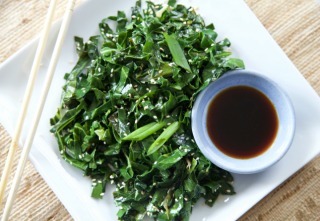 This is a very simple recipe, with one secret ingredient: a little splash of fish sauce to add umami flavor to dark, leafy greens.
This is a very simple recipe, with one secret ingredient: a little splash of fish sauce to add umami flavor to dark, leafy greens.
Sautéed greens are a quick and very healthy side dish for any meal. The most common set-up is olive oil, garlic and greens (which is delicious) but this recipe assumes that you want even more flavor, or perhaps a different type of flavor that will make greens more interesting (and less bitter).
Fish sauce is just the thing. It only takes a teaspoon of high-quality fish sauce to boost the flavor of greens. You can stop there, or add even more layers of flavor with ingredients like coconut milk, ginger, or red pepper flakes.
If dark leafy greens aren’t a regular part of your diet, use this recipe as inspiration to start eating more.
Servings: 2- 4
Time in the Kitchen: 15 minutes
Ingredients
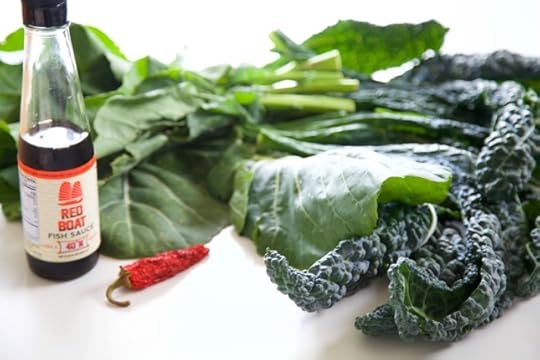
1 tablespoon Primal Kitchen® Avocado Oil (or other oil) (15 ml)
1 bunch dark, leafy greens (try kale or collards), leaves torn from stems and cut into thin strips*
4 scallions, thinly sliced
2 garlic cloves, thinly sliced
1 teaspoon fish sauce (5 ml)
Variations:
Use coconut oil instead of avocado oil
Add ¼ cup/60 ml coconut milk at the same time as the fish sauce
Add red pepper flakes, or a sliced hot chili when garlic is added
Add chopped ginger when garlic is added
Try different types of greens: kale, collards, Swiss Chard, mizuna, bok choy
Instructions

*The easiest way to chiffonade, or thinly slice, the leaves of greens is to tear or cut the leaves from the stems, stack a few leaves into a pile, then roll the pile into a tight cigar and slice
Heat a wide skillet over medium-high heat. Add oil. When the oil is hot and shimmering, add green onions. Cook until lightly browned, 3 minutes. Add garlic, then quickly add greens in handfuls, stirring and adding more as the greens wilt.
Sauté about 3 minutes, stirring the greens several times and adding more oil if the skillet seems dry.
Add fish sauce. Stir and cook 20 seconds more, then turn off heat and put a lid on the skillet. Let the greens sit for 3 minutes, to steam and soften, before serving.

The post Midweek Quick Cooking: Easy Sautéed Greens with Fish Sauce appeared first on Mark's Daily Apple.



March 20, 2018
A Look At Swerve Sweetener
 As we move into a new era of health awareness, there’s more variety than ever available to us. Overall, this is a very good thing—the average Primal consumer now has far greater access to a wider range of organic, free range, pastured, GMO-free, wholesome foods and products.
As we move into a new era of health awareness, there’s more variety than ever available to us. Overall, this is a very good thing—the average Primal consumer now has far greater access to a wider range of organic, free range, pastured, GMO-free, wholesome foods and products.
But this presents something of a dilemma when it comes to gray areas like sweeteners. While I don’t have much of a sweet tooth myself, I’m not a anti-sweetener purist either. While I lean toward stevia or monkfruit, I get a lot of questions about sugar alcohols, in particular a product called Swerve Sweetener, particularly from the keto crowd.
What To Know
Swerve Sweetener is a “natural” sweetener blend. Loved by low-carb and keto bakers, Swerve provides a similar level of sweetness to sugar and an ability to caramelize, making it an easy sweet substitute in many recipes. According to the manufacturers, Swerve is “zero-calorie, non-glycemic and safe for those living with diabetes, since it has no effect on blood glucose or insulin levels.”
That all sounds dandy, but what’s actually in the stuff? Swerve Sweetener is composed of erythritol, oligosaccharides, and natural flavors. Let’s break it down further.
Erythritol
Erythritol is a sugar alcohol that comprises the bulk of Swerve. In comparison to sugar, it’s said to be 60-70% as sweet and have a similar taste profile.
But that’s where the similarities stop. Containing a mere 0-0.2 calories per gram, erythritol is virtually calorie free.
As a sugar alcohol, erythritol is made from fermented glucose, usually sourced from corn. Considering Swerve uses only non-GMO corn, this probably isn’t too much of a concern for most folks, but it’s something to note. While the fermentation aspect is “natural,” there are certain synthetic processes along the erythritol production line, including hydrolysis to extract the glucose from corn or other fruits/veggies, and a crystallization phase to form the final product.
All in all, not too bad as far as sweeteners go. The scientific literature is positive regarding erythritol, showing no adverse effects on blood sugar and demonstrating beneficial effects on vascular function and oral health. Swerve also claims that erythritol is non-allergenic and less likely to cause digestive issues than other polyol sweeteners like xylitol. Good times.
Oligosaccharides
Next down the ingredient list are oligosaccharides. These are a type of prebiotic fiber otherwise labelled as inulin, providing additional sweetness for your tastebuds and a beneficial food source for all the little good guys hanging out in your gut. The oligosaccharides found in Swerve are likely sourced from starchy root vegetables like chicory root, onions and garlic.
Once again we have an ingredient that’s natural (in origin, at least), provides a beneficial effect in the GI tract, and doesn’t adversely effect blood sugar. That being said, those folks sensitive to FODMAPs might not react well to Swerve, on account of the oligofructose found in plants like chicory root.
Natural Flavors
This is where Swerve lets the team down a bit. Under the FDA’s Code of Federal Regulations, any compound can be deemed a “natural flavor”, provided it was sourced from something natural. All well and good. But there’s very little legalities surrounding how that natural compound can be processed to form the end product (aka the natural flavor): it could be fried, distilled, squashed, roasted, acidified, discombobulated, or all of the above – just whatever takes the manufacturer’s fancy.
And by the time that natural compound makes it into your sweetener, it’s no more natural than the artificial flavors in the cheaper sweeteners further down the aisle. Can this flavor really be considered natural, then? I think not.
What’s more, Swerve has no legal obligation to disclose what that natural flavoring was actually derived from. On their site, there’s vague references to “natural flavor from citrus”, but really that doesn’t mean a heck of a lot in the grand scheme of things.
The Science On Swerve
Once again, the literature is overwhelmingly in favor of Swerve Sweetener. With regards to erythritol, high-dosage trials in rats (up to 4.6 g/kg) failed to show any chronic toxic or carcinogenic effects. Human trials at lower dosages (1 g/kg body weight—still a decent amount) didn’t reveal any gastrointestinal concerns or digestive upset, aside from higher fluid intake. That being said, there are anecdotal reports of some people personally not taking well to the stuff.
On the oligosaccharide front, it’s also reasonably smooth sailing. Oligosaccharides like those used in Swerve have been positively associated with improved gut microbial health and permeability, but there is a certain propensity for prebiotics like these to increase flatulence and have a mild laxative effect. Fair warning. Maybe it’s another reason to embrace the adage “a little goes a long way” here.
Then there’s the natural flavors. There’s not a lot I can speak to here, not being privy to the actual contents of said natural flavors. It’s worth noting, however, that while the FDA requires natural flavors to be sourced from compounds that are considered GRAS, there have been times when GRAS ingredients and products have been taken off the shelves because the FDA didn’t do their homework.
Final Thoughts
At face value, and even below the surface, there’s nothing to complain about: Swerve Sweetener really does seem like the real deal. But it’s not my favorite sweetener when I reach for one, especially when I get that strange cooling sensation on the tongue after eating something sweetened with it.
But the fact remains that most people tolerate Swerve well, and it’s won over much of the keto crowd—arguably some of the most discerning of all foodies. If you’re looking for a new sugar substitute, play around with Swerve, maybe mix it with other natural sweeteners to optimize taste, and see whether it works for you.
Thanks for reading everyone. Whats your take on Swerve? Do you use it? Tolerate it well? I’d love to hear your feedback.
The post A Look At Swerve Sweetener appeared first on Mark's Daily Apple.



March 19, 2018
Dear Mark: Vitamin B and Lung Cancer, Folate Stability in Liver, and Less DNA Damage on No Produce
 For today’s edition of Dear Mark, I’m answering three questions from readers. First, what do I make of the recent study showing a link between lung cancer in men and supplementation with vitamin B6 and vitamin B12? Next, how stable is folate in liver? Other foods with high folate content before cooking, like legumes and greens, lose a lot during cooking. And finally, what’s my take on the old study where subjects’ markers of oxidative damage improved after eating a diet bereft of produce?
For today’s edition of Dear Mark, I’m answering three questions from readers. First, what do I make of the recent study showing a link between lung cancer in men and supplementation with vitamin B6 and vitamin B12? Next, how stable is folate in liver? Other foods with high folate content before cooking, like legumes and greens, lose a lot during cooking. And finally, what’s my take on the old study where subjects’ markers of oxidative damage improved after eating a diet bereft of produce?
Let’s go:
Mark, I wonder if you’ve seen the study linking lung cancer in men with vitamin B supplementation: http://ascopubs.org/doi/abs/10.1200/J...
What do you think?
Interesting study, thanks.
Supplementation with vitamin B6 or B12 was not associated with lung cancer risk in women.
Supplementation with vitamin B6 or B12 was associated with lung cancer risk in men, but only if those supplements were taken separately. If they supplemented with either vitamin as part of a multivitamin, the risk disappeared.
In other studies, vitamin B6 appears to be protective against most types of cancer, including lung cancer. Circulating levels of vitamin B6 protect against lung cancer. People with low “functional” vitamin B6 status—meaning they have low levels of active vitamin B6—have a greater risk of lung cancer.
Here’s what I think is going on: The study is capturing people with vitamin issues and disorders that cause deficiencies. People who take high dose vitamin B6 or B12 are more likely to have those disorders. They’re more likely to have low levels of the vitamins. They’re more likely to be prescribed vitamin supplements to make up for the deficiency. They’re probably even more likely to be unhealthy; many people take vitamins as an antidote to poor health.
Maybe supplementing isn’t good enough to overcome the inherent deficiency, or the condition causing the deficiency. Maybe these people aren’t converting supplemental vitamin B6 into the active, “functional” form that protects against cancer. Many of the participants were smokers at baseline, and the vitamin-mediated risk of cancer went up in those who smoked. Maybe they’re taking vitamins in response to an underlying disease state.
Those underlying disease states change how vitamin B6 acts in the body. In one study, “functional” B6 status was protective against lung cancer, while another type of biomarker measuring the catabolism of B6 due to inflammation, was linked to a rise in lung cancer. Low-grade inflammation is often high in states of disease or general unhealthiness, and B6 catabolism is a strong predictor of all-cause mortality.
It does seem that cooking affects these folate sources differently. If you compare cooked (boiled, drained) legumes, lentils come out on top! (Although liver is still king.)
This is true.
Animal-sourced folate is quite stable whether you freeze it or cook it.
I should say that overcooking your liver will deplete the folate. 12 minutes of frying in corn oil until 158°F/70°C caused a 50% loss of folate. 16 minutes of broiling until 158°F/70°C caused a 40% loss. That’s an obscene amount of cooking. Cooked liver should be pink inside. Creamy, not grainy. Even then, you still maintain at least half of the already generous amount of folate.
Older studies got better results, with fried beef liver losing between just 11-15% of folate. They probably weren’t overcooking it.
A ghost said:
I’d love to hear your opinion on this study:
https://www.ncbi.nlm.nih.gov/pubmed?D...
Man, I wish I could get my hands on the full study. I’ll comment, but keep in mind that I’m only going off the abstract. Consider this fun speculation, not iron-clad conclusion.
Researchers took 8 smokers and 8 non-smokers, removed all concentrated sources of flavonoids from their diet, and fed them meat patties dosed with green tea extract for 10 weeks. This amounted to a “fruit-and-vegetable-free diet,” as produce is the richest source of flavonoids.
Green tea extract had some positive effects on postprandial oxidative stress, but they didn’t last. The half life of the extract in the body was 2 hours. As the subjects peed it out, the antioxidant capacity returned to normal.
What’s weird is that oxidative damage to DNA, lipids, and blood proteins all decreased over ten weeks despite the subjects eating no produce and the green tea extract only improving antioxidant capacity for a few hours postprandial.
Maybe the diet was dense with vitamins and minerals. After all, vitamins and minerals serve antioxidant functions and provide building blocks for the production of endogenous antioxidants like glutathione.
Maybe most of the oxidative damage our DNA, lipids, and blood proteins face occurs immediately after eating. If so, the postprandial increase in antioxidant capacity could have made all the difference.
We don’t know enough about the rest of the diet to say anything else or do anything but make guesses. They weren’t only eating the green tea meat patties. They ate other stuff, too—a “strictly controlled diet” absent fruits and vegetables. I really wish I could get my hands on the full paper.
That’s it for today, folks. Help out down below if you have anything to add, ask, or proclaim!
Take care, be well, and Grok on.
The post Dear Mark: Vitamin B and Lung Cancer, Folate Stability in Liver, and Less DNA Damage on No Produce appeared first on Mark's Daily Apple.



March 18, 2018
Weekend Link Love — Edition 495
 Research of the Week
Research of the WeekNearly 47 million Americans are estimated to have preclinical brain changes associated with Alzheimer’s.
Your coffee habit influences your endocannabinoid system, (but not how a cannabis habit does).
There’s a telling connection between stiff ankles and deep squat difficulty in the West.
Evolve or die.
Major depression doesn’t look the same (molecularly speaking) in men and women.
Looks like an animal-free agriculture may not be as “holistically sustainable” as many would hope.
New Primal Blueprint Podcasts
 Episode 227: Cavin Balaster: Host Elle Russ chats with the author of How to Feed a Brain.
Episode 227: Cavin Balaster: Host Elle Russ chats with the author of How to Feed a Brain.
Each week, select Mark’s Daily Apple blog posts are prepared as Primal Blueprint Podcasts. Need to catch up on reading, but don’t have the time? Prefer to listen to articles while on the go? Check out the new blog post podcasts below, and subscribe to the Primal Blueprint Podcast here so you never miss an episode.
Interesting Blog Posts
Elephants tend to be “righties,” too.
How we move into wisdom…
Media, Schmedia
Vegetarian menu sections undercut their intent.
Go ahead and sniff (isopropyl) alcohol.
Everything Else
I knew there was something special about the platypus.
And, also on that note, pond scum redeems itself.
Two years now, and 7% of astronaut Scott Kelly’s genetic expression hasn’t returned to baseline.
I’ll wait for the iOS version.
What nut-cracking techniques tell us about animal behavioral diversity.
Things I’m Up to and Interested In
Concept I’d never really considered: hard times as “palate cleansers.”
Evidence that pleasantly surprised me: humans 74,000 years ago thrived through a supervolcanic event and fallout.
Food for thought: 8 youth sports myths
News that saddens me: elderly Japanese women are committing more crimes—often to purposely go to prison.
Announcement I’m pleased to, well, announce: Primal Kitchen® now has Avocado Spray Oil.
News I was happy to read: Before he died, Stephen Hawking became the voice of The Hitchhiker’s Guide To the Universe.
Recipe Corner
A good thing to happen to kimchi if I do say so myself—Primal Kitchen® Sesame Ginger Slaw.
Because everyone can use a delicious 15-minute dinner…
Time Capsule
One year ago (Mar 11 – Mar 17)
The Emerging Science of Electrostimulation – It’s stimulating.
19 Personal Care Products I Use or Like – What you’d find in my medicine cabinet
Comment of the Week
“Pro tip: don’t do abdominal isometrics until after your daily BM.”
– We all live and learn, Clank.

The post Weekend Link Love — Edition 495 appeared first on Mark's Daily Apple.



March 17, 2018
Turmeric and Ginger Fish
 This recipe is a good reason to grab that bottle of turmeric in your spice rack and put it to work adding bright orange color and extra flavor to mild fish like cod. The slightly bitter taste of turmeric all but disappears when cooked with buttery ghee, ginger and garlic.
This recipe is a good reason to grab that bottle of turmeric in your spice rack and put it to work adding bright orange color and extra flavor to mild fish like cod. The slightly bitter taste of turmeric all but disappears when cooked with buttery ghee, ginger and garlic.
The shake of black pepper in the ingredient list is there for more than just seasoning; black pepper provides piperine, which is essential for absorbing curcumin. Curcumin is the whole reason to be eating turmeric in the first place, since it’s the part of turmeric that carries all the amazing health benefits.
You don’t necessarily need to supplement with turmeric if you’re cooking with it (as evidenced by all the home cooks in India.) This recipe for turmeric and ginger cod shows how easy it is to use turmeric regularly as a spice. Turmeric is also easy to add to scrambled eggs, soup, and curries.
Servings: 4
Time in the Kitchen: 25 minutes
Ingredients

4 4-ounce/113 g boneless, skinless cod filets (or other flaky white fish)
1 teaspoon ground turmeric (5 ml)
1-inch piece ginger, peeled and finely grated* (25 mm)
1/2 teaspoon salt (2.5 ml)
¼ teaspoon ground black pepper (1.2)
¼ cup Primal Kitchen® Avocado Oil (60 ml)
4 tablespoons ghee or unsalted butter, divided (60 g)
2 garlic cloves, finely chopped
1/2 cup chopped dill (15 g)
Instructions

Recipe Note: A microplane zester works well for finely grating ginger.
Mix together turmeric, ginger, salt, pepper and avocado oil. Rub fish on all sides with the mixture.
In a large skillet, heat 2 tablespoons ghee over medium-high heat. When the ghee is hot, add the fillets. Cook until the fish is lightly browned and starting to get firm, 2 to 4 minutes, depending on the thickness of the fillets.
Using a wide spatula, flip the fillets over. Add remaining ghee to the skillet with the garlic and dill.
Cook 2 to 4 minutes more, until the fish easily flakes apart.
Lift the fillets onto a platter. Use a rubber spatula to scrape all the remaining ghee and bits of dill and garlic over the fish. Serve, and enjoy!
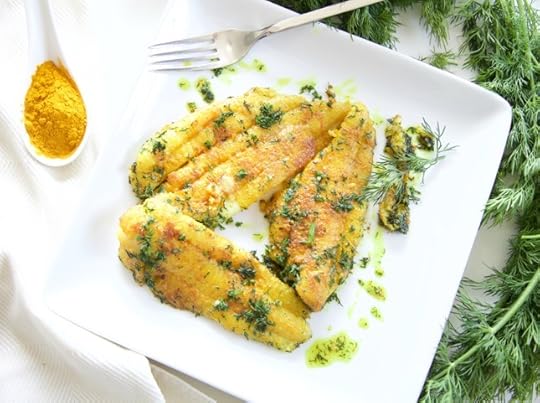
The post Turmeric and Ginger Fish appeared first on Mark's Daily Apple.



March 16, 2018
The Entrepreneurial Spirit: Making an Impact As a Primal Health Coach
 In a newsletter last week, I shared the impetus behind the creation of the Primal Health Coach Institute, the world’s first ancestral health coaching school, and teased you with the promise of motivational success stories to come. Well, today’s the day to feel inspired as we see just how many lives a Primal Health Coach education can touch.
In a newsletter last week, I shared the impetus behind the creation of the Primal Health Coach Institute, the world’s first ancestral health coaching school, and teased you with the promise of motivational success stories to come. Well, today’s the day to feel inspired as we see just how many lives a Primal Health Coach education can touch.
Most of these coaches were once Mark’s Daily Apple readers like you. They had their own personal health stories and successes and felt the “primal” call to help others. Just as our Paleolithic ancestors traversed the vast terrain, hunting and foraging across continents, Primal Health Coach Institute graduates are branching out into many areas…from restaurant owners to clinicians…from authors to food photographers.
Many Primal Health Coaches form their own businesses and go straight into the most traditional route of offering one-on-one in-person coaching; the “private practice” model. Others plan to jump in to the up-and-coming Functional Medicine realm, working with clinicians and other health care providers in a preventive health model. But, in fact, the entrepreneurial opportunities are endless, as shown by our graduates’ varied accomplishments.
Here are just a few standouts:
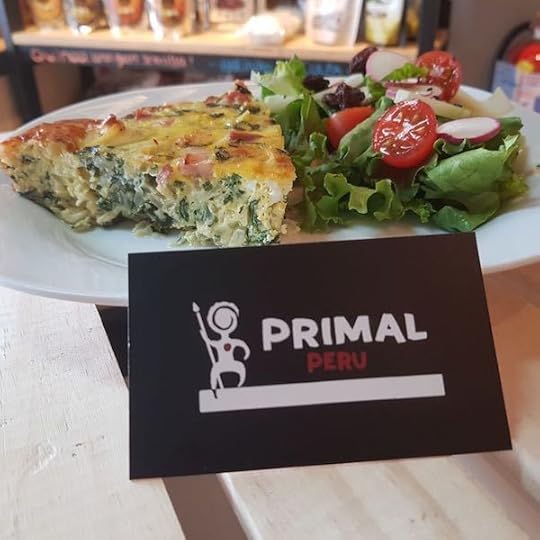
Barbara Vieira Gomes has opened a Primal health food store and cafe in Lima, Peru and gave us a shoutout on social media: “Thank you #marksisson and team of #primalblueprint! You inspired me, changed my life and health. So now in Lima Peru (South America) yesterday we opened the first #primalperu health store and cafeteria! It has been a roller coaster of followers and more! A dream to share your vision!”

Chris Becker has pivoted his consulting business to cater to health coaches wanting to start and grow their businesses: “Knowing about nutrition, fitness and other healthy lifestyle factors is important, but unless they have the skills to effectively share that information with others, their contributions are going to be limited. I strive to equip coaches with strategies to build their brands, deliver value to their clients, and have a greater impact on the well being of their clients and society as a whole. I help coaches with their website design and optimization, email list building and automation, pricing and sales tips, as well as social media strategies to increase their reach.”


Donna Crous transformed her food blog into a full-blown Paleo food photography business and wrote in to tell us: “Never in my wildest dreams did I ever expect a career like this when I hit the button to start my Primal Health Coach studies. I love making healthy recipes and showing people how exciting primal eating can be and the many delicious options available…More importantly though, it is about meeting incredible like-minded passionate people within this amazing community.”

Miléna Sinka (aka the Barefoot Superhero) has written and published three books on primal topics and has another coming out this year, along with two successful online nutrition courses serving fellow Hungarians.

Adan Rios has been hired as a health coach by a clinic (Virta) that specializes in type 2 diabetes reversal, and he credits his Primal Health Coach education: “Virta loved that I was a certified health coach and that I was steeped in low-carb eating to help lose weight and lower blood glucose and A1C levels. They also loved that I had experience working with clients. It’s been a great experience working at Virta and I am only one month in, but already one of my patients has discontinued his insulin after a few days of treatment!”

Dentist Al Danenberg has parlayed his Primal Health Coach education into a rewarding speaking career, securing spots at the Ancestral Health Symposium in Seattle, WA and this year’s Paleo f(x) in Austin TX.
The Primal Baker, Ana Gonzalez, reinvented her career, going from sugary pastry chef to paleo/primal fit chef extraordinaire. She checked in to tell us that her business is thriving and growing and that customers love it, so much so she branched out into a meal-planning service.

Primal Health Coach Erin Power has coached over 200 clients to lasting health and built a lucrative health coaching business. She says, “The Primal Health Coach program is what took my business from a wobbly, uncertain start-up, to a growing and proven mini-empire that actually helps people enact massive lifestyle change in an accessible way.”

Ste Lane of Peak Primal Health is opening a primal bed and breakfast: “My wife (Nicole) and I are taking over a B&B in north eastern PA. We are collaborating with local farmers to bring only the best possible food to the inn. Grass fed and finished meats, organic produce and sustainable eats. Our focus is to provide people the perfect countryside getaway for those who are looking to disconnect from the stresses of modern/city life and reconnect with themselves and nature in a beautiful country setting.”

Angus McDonald has blended his passion for primal and his past experience as a copywriter to help other coaches with their marketing: “As a copywriter, I’m trained to write sales and marketing material, and an area I’m really interested in is helping businesses connect with potential customers through effective lead generation strategies in their target market. I started noticing questions about marketing and how to attract clients in the PHC Facebook groups, so I thought I could offer my experience and knowledge to help other coaches move ahead with their businesses. The primal health knowledge that Mark has taught us, has the potential to massively change people’s lives and I think we have a duty to share it with as many people as possible.”

And then, of course, there is Primal Health Coach’s very own Laura Rupsis, who transformed her CrossFit box into a veritable success model through the guidance of our ancestral health coaching program.
There are many more success stories where those came from. If you’re interested in learning more about how graduates are using their certifications to build profitable businesses and share the primal lifestyle across the globe, visit the Primal Health Coach Success Story page.
Some health coaching programs primarily prepare their graduates for success in a particular niche, like working in a clinical setting, for instance. But we’ve worked hard to set our graduates up for success across a wide range of coaching modalities, including…
one-on-one coaching
online coaching
group coaching
gym health coaching
corporate health coaching
clinical setting coaching, etc.
…as well as artistic paleo pursuits that involve cooking, photography, and writing, by supporting the entrepreneurial spirit exhibited by so many of our coaches. There’s more than one way to help people lead healthier lives when you are armed with the nutrition knowledge and coaching skills you garner from the Primal Health Coach program.
So if you, like the Primal Health Coaches mentioned above, are a Mark’s Daily Apple reader ready to take all that you’ve learned about living a primal life and turn that burgeoning knowledge into an actual money-making endeavor, then I encourage you to follow this link to learn more: How to Become a Health Coach.
Finally, stay tuned for more news on health coaching in the coming weeks where I will be sharing what’s next for Primal Health Coach and how you can get involved. There are lots of exciting updates coming to the program in the next few months, and I’m looking forward to giving you the first glimpse.

The post The Entrepreneurial Spirit: Making an Impact As a Primal Health Coach appeared first on Mark's Daily Apple.



Mark Sisson's Blog
- Mark Sisson's profile
- 199 followers








